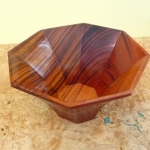I’ve been making various things out of koa and mahogany for some years; mostly smaller items like mirror frames, children’s furniture and jewelry boxes. I’m interested in trying something bigger and more complex, like a hallway table and perhaps complimentary pieces. The cost of koa is very high and I’d like to keep the project affordable, so although I like the very luminous look of koa, I’m considering other woods. From various web sites and books I’ve seen that Tasmanian Blackwood is considered a near cousin to koa and I wanted ask if anyone has worked with this wood and if so, what properties they found and any advice they may have for joinery and finishing.
Jim W.
















Replies
Bear10-
At this very moment I am a student in Tasmania. I have used alot of Tasmanian blackwood. It is a cousin to koa and has alot of the same colors and figures you can get with koa. I am hawaiian but have never actually worked with koa. But they look alot alike.
As for working with Tasmanian Blackwood have fun. It is a great wood, but it is very hard to work. You have to always work with the grain. Because when it chips out it really chips out. You will lose hugh chunck of wood. It works really nicly with hand tools and planes. If you work with the grain it is a beautiful timber to use.
Please don't be scared of it,because it is a beautiful timber. There is a great article on working blackwood in the australian wood review magazine, by Evan Dunstone.
I have attached a 2 pictures of some furniture that I have made with blackwood. The first are 2 stools and the second is a chair. The outer frame of the chair is made of blackwood, the seat and back are made of brazilan walnut.
I hope this helps. Like I said just be careful of the grain direction and all will be great.
http://www.kalafinefurniture.blogspot.com
Tasmanian Blackwood ..
I have no idea but if you send me a few hundred board feet of it I will let you know what I find out!
Looks like nice wood!
Other post.. "Because when it chips out it really chips out."
I use Purpleheart quite a bit and it sounds like your wood may work the same.
I find the Purpleheart (and sometimes Jatoba) are impossible to plane (A sharp scraper works the best for me) and when routing either.. SMALL and many cuts to final dimension.. I also find that when cutting a curved surface on either all will seem OK and then a check will show up where least expected. If your wood is the same try to cut/fine tune everything BEFORE glue-up.
Just this week I had a check show up in a curved surface (already glued up) when I applied several coats of Danish oil to some Purpleheart. The oil must have swelled the wood pores and it let go. Damn, I had to cut off both ends of the table top and start over.. BUMMER!
Edited 9/6/2007 8:14 pm by WillGeorge
Edited 9/6/2007 8:29 pm by WillGeorge
Bear,
I use it often.
It takes a polish well.
As kaleo said, tearouts can be big.
As well, it's a bit harder than the eucalypt timbers - tends to wear tooling quickly.
Most importantly, the dust is allergenic for some (including me.)
CHeers,
eddie
This forum post is now archived. Commenting has been disabled